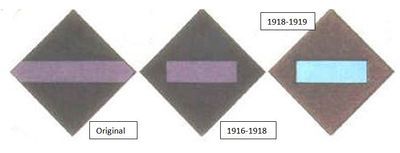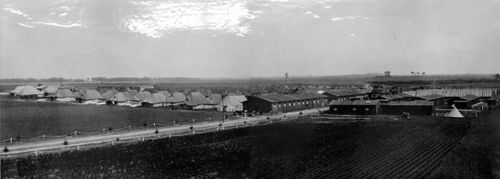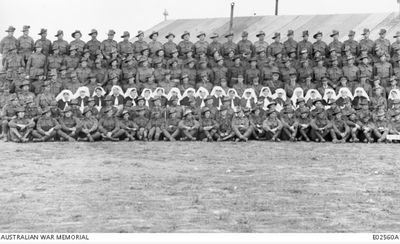Difference between revisions of "3rd Australian General Hospital"
From Our Contribution
| Line 6: | Line 6: | ||
| subheader = | | subheader = | ||
| − | | image = [[File:3rd_AGH.jpg]] | + | | image = [[File:3rd_AGH.jpg|400px]] |
| caption = Colour Patch of 3rd Australian General Hospital | | caption = Colour Patch of 3rd Australian General Hospital | ||
| − | | image2 = [[File:3rd_AGH_Lemnos.jpg| | + | | image2 = [[File:3rd_AGH_Lemnos.jpg|500px|]] |
| caption2 = 3rd Australian General Hospital on Lemnos | | caption2 = 3rd Australian General Hospital on Lemnos | ||
| − | | image3 = [[File:3AGH_France_1918.jpg| | + | | image3 = [[File:3AGH_France_1918.jpg|500px|]] |
| caption3 = 3rd Australian General Hospital Abbeville France | | caption3 = 3rd Australian General Hospital Abbeville France | ||
Revision as of 00:48, 4 March 2018
General Information
Left Circular Quay, Sydney on the RMS Mooltan on 5 May 1915. Staff were mostly drawn from Sydney, and later reinforced from Victoria and South Australia. During the second half of 1915 the 3rd Australian General Hospital deployed to Mudros on the Greek island of was on Lemnos to nurse sick and wounded patients from Gallipoli.
Equipment was landed at Turk's Head, West Mudros on 5 Aug 1915, with the sisters and nurses landing on the 7th and 8th. Supplies and equipment did not arrive in a timely manner, and things were therefore in rather a state of chaos when the wounded began to arrive. Their dressings, which had been applied on the hospital ships, were saturated and covered with flies. Mattresses had to be placed on the floors of the marquees, and blankets used as pillows. Fortunately, little bed-covering was needed, as the weather was intensely hot, and the patients were clad in coarse calico shirts, and the clothing which they wore in the trenches. Despite the hospital operating in a hostile environment, their mortality rate was only 2 percent.
Initial patients were those injured in the August attempt by the allies to break out from their restricted position. Later patients were almost exclusively ill with dysentery or paratyphoid, and many of the staff also fell ill. In late November and December 1915 the patients were exhibiting the effect of the weather on men who had inadequate uniforms - severe frostbite included.
The hospital was expanded to 1,000 beds as part of the preparation for the expected heavy casualties when the troops were to withdraw from Gallipoli.
With the withdrawal from Gallipoli, the hospitals on Lemnos were disbanded, and the nurses boarded SS Oxfordshire on 14 Jan 1916 and sailed on 17 January for Egypt.
3 AGH was re-established at Abbassia in Egypt in early 1916 in an old harem, where it remained in operation for eight months. The staff then operated the Kitchener War Hospital at Brighton, England from October 1916 until they moved to France in May 1917 with 91 nursing staff.
In France it then operated from tents and huts at Abbeville, in the Somme area of France. For most of its existence on the Western Front (May 1917 to May 1918) it admitted gassed patients and treated them briefly before sending them to other places. During the German 1918 offensive, 3 AGH operated as a Casualty Clearing Station, with some wounded appearing direct from the battlefield via motor vehicles and other transport.
3 AGH was closed for admissions on 16 Apr 1919, and was instructed to be ready for withdrawal from France by May 20th. Nursing staff returned to England in parties of 10, with the last leaving France on 23 May 1919.
Staff
Soldier Patients by date admitted
Lemnos Island Aug 1915 - Jan 1916
- Frederick William Wallace Moore 20 Dec 1915 - 9 Jan 1916
Abbassia Egypt
- Henry McCavana 29 Mar 1916
Brighton England
- Frank Moore 21 - 30 Nov 1916
- Charles Henry Partridge 6 Mar - 1 May 1917
Abbeville, France May 1917 - May 1919
- Clarence Henry Batt 8 - 21 Dec 1918
- Ernest Albert Batt 9 - 21 Dec 1918
- Thomas Ramsell 14 - 29 Apr 1919




